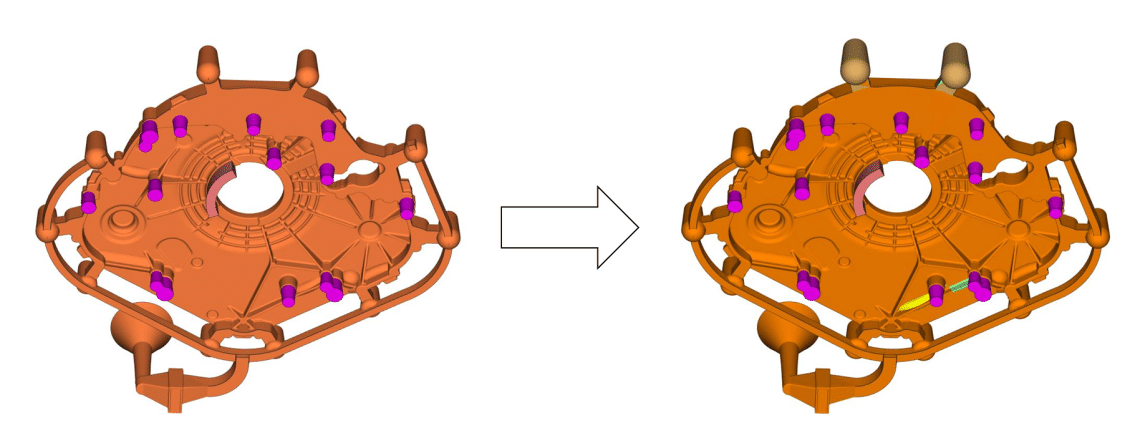Optimization of a Sand Casting with FLOW-3D CAST
Optimization of a Sand Casting with FLOW-3D CAST
This blog was contributed by Malte Leonhard, Flow Science Deutschland.
Optimization of casting design and runner/riser system supported by simulation
In order to verify that FLOW-3D CAST can reliably predict such casting defects, the existing casting was simulated and the results compared with the real casting defects. This video shows that the FLOW-3D CAST defect analysis correctly reproduced the defects and their position.
The simulation results suggested that reversing the casting direction might be beneficial, so the casting part was rotated by 180° in the mold. Next, the runner and riser system were modified so that most of the risers were integrated into the runner (“hot risers”).
Additionally, design changes of the casting, which we will discuss later in the article, were introduced in order to achieve a directed solidification to the risers and to avoid porosities in the casting.
Finally, chills were applied in areas of large mass accumulations to reduce shrinkage defects.
A filling and solidification simulation showed that these measures significantly reduced the casting defects. These simulation results were again validated by X-rays. Near the “cold risers”, those not integrated into the runner system, not all defects could be avoided due to the risers’ insufficient size.
In the last version, the two cold risers were enlarged. Minor design changes of the casting were introduced to improve the directional solidification to the risers.
Compared to the original design, the casting quality was substantially improved and the amount of return scrap reduced. The use of chills improved the quality in critical areas within the casting. Overall, the casting process is now more efficient and cost-effective for the foundry.
| Total sprue material | 3,73 kg | (-3,3 kg) |
| Pouring weight | 8,93 kg | (-3,19 kg) |
| Yield | 58 % | (+24%) |
| Chills | 1,53 kg | (+1,26 kg) |
Design modifications of the casting
In many cases it is not sufficient to optimize the runner and riser system to achieve a sufficient casting quality. Instead, the design of the casting itself needs to be changed for the sake of “castability”.
The functional design of a casting often includes mass accumulations that prove problematic in the casting process. To achieve a high-quality microstructure, the wall thickness should always increase towards the risers according to the thermal modulus method.
To illustrate the effect of the casting design modifications, two geometry versions with identical runner and riser systems are compared. The adjustments are shown in the figure below. Several wall thicknesses and ribs between material accumulations have been enlarged.
For demonstration purposes, the two marked ribs will be examined. In both cases, porosities occur at the junctions, which is not acceptable.
By increasing the wall thicknesses of the ribs, the junctions are connected to the feeders adjacent to the casting edge and a directed solidification toward the risers is achieved.
The video shows large porosities in the initial version on the left side due to large hot spots within the casting where solidification-induced shrinkage creates a deficit.
In the optimized version on the right, the melt solidifies in the direction of the risers. This means that the deficit can be compensated by the riser and no porosity is created in the casting.
This validation shows a good correlation between reality and simulation in FLOW-3D CAST. The software is an effective tool for the development of castings, casting systems, feeder dimensions/shapes, and casting processes to ensure optimal quality and efficiency.




